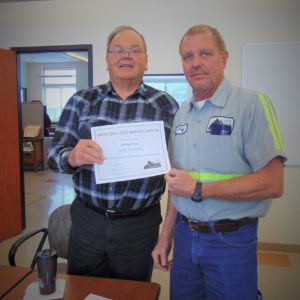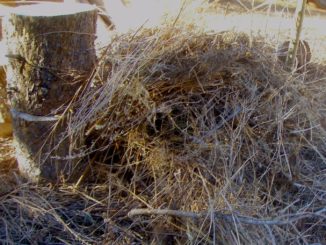
Marty Metzger
[email protected]
You arrive home on trash pickup day and retrieve your emptied garbage/recycle can from its weekly place of prominence at the end of your driveway (or in the street where mine often ends up). Perhaps you haul your loads of rubbish directly to the landfill. Either way, that’s usually the last thought any of us give to once necessary or even treasured items. Rarely does anybody think about inanimate objects’ final resting place. Until now.
The Larimer County Landfill, located on South Taft Hill Road in Fort Collins, has been unassumingly serving much of Northern Colorado’s disposal needs for decades. Not the type of place that gets much fanfare. Until now.
Ponder for a moment the question: “What all is in there?” Oh sure, household waste, broken furniture and some kid’s temper-tantrum annihilated riding toy await their fate beneath a swirling mass of eager gull wings while gigantic earth-moving machines attack from the side.
“Brrroar, brroar,” and it’s all instantly buried like yesterday’s political promises. But… what’s really in there?

Jeff Boltz, Solid Waste Assistant Director for the county, shared some dandy stories about that. For instance, on February 2, while others were nail-biting about some back-East gopher’s winter vs. spring prediction, a poor red-tailed hawk had met its maker. An observant customer spotted someone tossing the bird’s lifeless body into the waste stream. A landfill equipment operator who was notified pulled the dead creature out, while other landfill personnel contacted the Colorado Department of Wildlife to come get the deceased hawk. That’s when everyone learned it’s a Class 3 felony to harm or even bury a protected bird. (Take that, common groundhog!)
Noteworthy numbers of creatures once accepted for internment were retired lab specimens, including an elk fetus, snakes and ubiquitous frogs. That previously practical practice is now a no-no because the animals were contained in glass jars filled with formaldehyde, a chemical banned from landfills by current rules and regulations. But that risk seems tame compared to the kind that can go “Boom!”
Boltz recalled items the City of Loveland Bomb Squad regularly brings in. Ammunition, fireworks, lab-grade chemicals and other recipes with “rockets’ red glare” potential are disposed of by the law enforcement professionals.
The general public does its part, albeit often unknowingly, to dispose of hazardous materials. This past summer, said Boltz, a customer dropped off a 1940s pyrene (toxic to the kidneys and liver) fire extinguisher; the summer before, another man brought in an also 1940s Montgomery Ward flame sprayer!
Potential peril, however, can be solely in the eye of the beholder. Boltz reported that, about five years ago, the landfill was just about to close early on one particularly windy day. That’s when a last-minute customer opened his truck doors: “Cha-ching!” The hurricane-force gusts blew his entire employee payroll of cash out and clear across Taft Hill Road! Only a small portion of the money was ever recovered.
Just as is danger, value is in the eye of the beholder. Right after New Year’s Day 2003, a frantic customer called the landfill, desperately imploring them to sift through the entire load of one incoming Gallegos Sanitation truck. When the vehicle in question arrived, it was pulled off to the side and emptied of its entire prolific contents, landfill employees on the ready for anything.
That’s when they learned the caller had been a mom who’d accidentally tossed out the Christmas ornaments her kids had made for her! Oops, followed by expletives.

Former Director Frank Lancaster had shared previous landfill highlights back in the mid-1990s. Somewhere out there once were about 1 million dollars in negotiable bonds a Fort Collins securities firm accidentally sent south while relocating their offices. A group of businessmen dressed in 3-piece suits and high-dollar shoes had demanded approval to dig through mountains of sludge to recover the precious documents. It’s unclear whether any or all were found.
One very lucky rabbit’s foot and all its attachments escaped the deadly bulldozers after his human family, also moving, erroneously set his cardboard box among ones containing trash. They hysterically called the landfill for help but were told their bunny surely hopped no more. A few weeks later, they were delightfully shocked to receive a call. Somehow the emaciated, bedraggled white hare had survived and eventually crawled into an equipment shed. He was fattened back up and shipped to his happy little girl in her new home several states away.
Most people have heard an old myth about the existence of an elephant graveyard. Supposedly, all pachyderms instinctively direct themselves there when they reach a certain age, in order to die away from the herd, thus not hindering the progress of those that remain behind. Tall tales have enticed greedy ivory poachers, people hunting for previous missing explorers thought to be held captive by elephant spirit guardians, and hunters for the mythical graveyard’s book of spells and incantations which bear the solution to global warfare.
On Aug. 3, 1996, an emaciated elephant called Hattie lost her chance to die with those of her own kind in some sacred cemetery. The 26-year-old female had actually been born in a tropical forest in India in 1970. From 1971 forward, she was shifted from zoo to zoo in the United States, until John Cuneo bought her from the Los Angeles Zoo in 1990. After Hattie’s death, Cuneo faced federal charges of violating the Animal Welfare Act by failing to provide his elephants adequate food, water, shelter and medical care.
While on her last tour with Circus Vargas, Hattie’s hind legs gave out during unloading, while en route from Illinois to California. It was while in Colorado that handlers noticed she was dead on the transport and took her carcass to Colorado State University for a necropsy. Joyce, another elephant on the tour, died the day of Hattie’s last show and was shipped to San Bernardino for a necropsy.
Post-mortem tests determined that both Hattie and Joyce had become the first American elephants to die of tuberculosis since the 1800s. Hattie’s remains were buried in the Larimer County Landfill without so much as a grave marker for the hard-working, long-suffering elephant. The landfill’s dead animal area was eventually moved and ultimately eliminated, so no one can even venture a guess as to where on the Larimer County property a few spirit guardians might still stand watch over a singular zoo/circus elephant named Hattie.
To learn more about what can and cannot be deposited in the Larimer County Landfill, visit their website https://www.larimer.org/solidwaste or follow them on Facebook at https://www.facebook.com/LarimerSolidWaste/ .

Support Northern Colorado Journalism
Show your support for North Forty News by helping us produce more content. It's a kind and simple gesture that will help us continue to bring more content to you.
BONUS - Donors get a link in their receipt to sign up for our once-per-week instant text messaging alert. Get your e-copy of North Forty News the moment it is released!
Click to Donate




That goes to show how much compassion circus animal owners have of their animals. They abuse them, use them for profit, then throw them in the trash. John Cuneo should have been fined and jailed for dumping the the elephant at a landfill. Thank-you Larimer County Landfill for burying Hattie in a unknown place where she can now privately, forever rip.